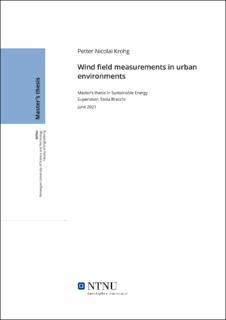| dc.contributor.advisor | Bracchi, Tania | |
| dc.contributor.author | Krohg, Petter Nicolai | |
| dc.date.accessioned | 2021-10-03T16:20:34Z | |
| dc.date.available | 2021-10-03T16:20:34Z | |
| dc.date.issued | 2021 | |
| dc.identifier | no.ntnu:inspera:80323674:35324878 | |
| dc.identifier.uri | https://hdl.handle.net/11250/2787168 | |
| dc.description.abstract | Ettersom verden streber etter å senke klima utslipp og forurensing blir fokuset mer og mer rettet mot fornybar energiproduksjon. Kan vind produksjon i urbane miljøer bidra til å senke både lokale og globale utslipp. Et problem med dette konseptet er at bygninger, og andre strukturer forstyrrer den naturlige vindstrømmen og forårsaker en rekke fenomener som gjør forholdene til en vindmølle krevende. Som en del av et større forskningsprosjekt på NTNU, skal denne studien evaluere vindforhold i et urbant strøk.
Hensikten med denne oppgaven er å kartlegge vindforholdene på et tak på en bygning i et urbant miljø for å øke forståelsen om hvordan vindstrømmen bil påvirket av de ytre faktorer. NTNU campus Gløshaugen ligger i Trondheim by, plassert på en høyde med bakker rundt hele området. Målingene skal utføres med et 3D ultrasonisk anemometer som måler vind hastighet, vind retning og temperatur. Disse parameterne skal brukes for å evaluere turbulens nivået, på ett av de to høyeste bygningene på Gløshaugen. Resultatene ble sammenliknet med to IEC standarder, og viste at disse standardene undervurderer turbulenser nivået i et urbant strøk. I tillegg til å sammenlikne resultatene med disse standardene, ble turbulens intensiteten delt opp i seksjoner på $30^\circ$, og viste at vind hastighetene økte når vinden blåste direkte på sørveggen av bygningen. Disse resultatene førte til en evaluering av den vertikale vind hastigheten som viste at anemometeret var plassert i akselerasjons sonen ved sørlige vind retninger. Det ble også avdekket at vindretningen endrer seg i snitt $26^\circ$ hvert minutt, noe som er ekstremt høyt sammenliknet med andre resultater fra andre rapporter. Siden vindhastigheten endrer seg så drastisk hvert minutt, er det sannsynlig at en vertikal akslet vind mølle passer bedre i dette tilfellet. Det ble også undersøkt hvordan den like høye bygningen rundt 50 meter nord for det aktuelle taket ville påvirke vindstrømmen uten at dette førte til noen spesielle funn. | |
| dc.description.abstract | In the quest of lowering global and local emissions, the topic of urban wind is increasingly more popular. The operating conditions for a SWT in an urban environment are harsh due to the complex wind flow and increased turbulence intensity levels caused by buildings and structures. In order to operate a wind turbine safely and reliably, the turbulence intensity at the specific site must be evaluated.
As a part of an ongoing campaign at NTNU, this study aims to measure and analyze the wind conditions on top of a building located at NTNU campus Gløshaugen in the city center of Trondheim. The measured values for wind speed and direction were performed using an ultrasonic 3D anemometer located on the top of one of the two tallest building at campus Gløshaugen. To evaluate the wind conditions the IEC standards IEC61400-1 and IEC61400-2 were used. As defined in the standards, the standard deviation of the horizontal wind speed was calculated for 10-minute intervals, and then used to calculate the turbulence intensity for every interval. In addition to the IEC standards evaluation, the turbulence intensity was calculated in sections of $30^\circ$ as stated in Measnet standard for evaluating site specific wind conditions to get a better understanding of how the surroundings affect the wind flow in terms of turbulence intensity and wind speed. Since the IEC standards evaluate the wind profiles in open rural areas, with a more uniform boundary layer the varying wind direction in an urban environment was evaluated using 1-minute intervals. Lastly, the vertical wind speed was analyzed to determine the impact of nearby buildings and obstructions present on the roof.
The comparison between the IEC standards and the calculated turbulence intensity at the site reviled that the standards underestimate the turbulence intensity in an urban environment, and is not suitable to evaluate sites with complex wind profiles. The turbulence intensity levels in the $30^\circ$ sections showed that the wind speeds were increasing as they approached the South wall of the central building. When these sections were compared to the vertical wind speed in the same sections, the results showed that the anemometer is located in the acceleration zone when the wind flow encounters the South wall. The results regarding directional changes in the 1-minute intervals showed an average directional change of $26^\circ$ from one minute to the next. This implies that a VAWT could be more suitable due to the rapidly changing wind direction on the roof. The influence from the other tall building on campus did not impact the results for vertical wind speed, Which was expected due to the short distance between them. | |
| dc.language | eng | |
| dc.publisher | NTNU | |
| dc.title | Wind field measurements in urban environments | |
| dc.type | Master thesis | |
